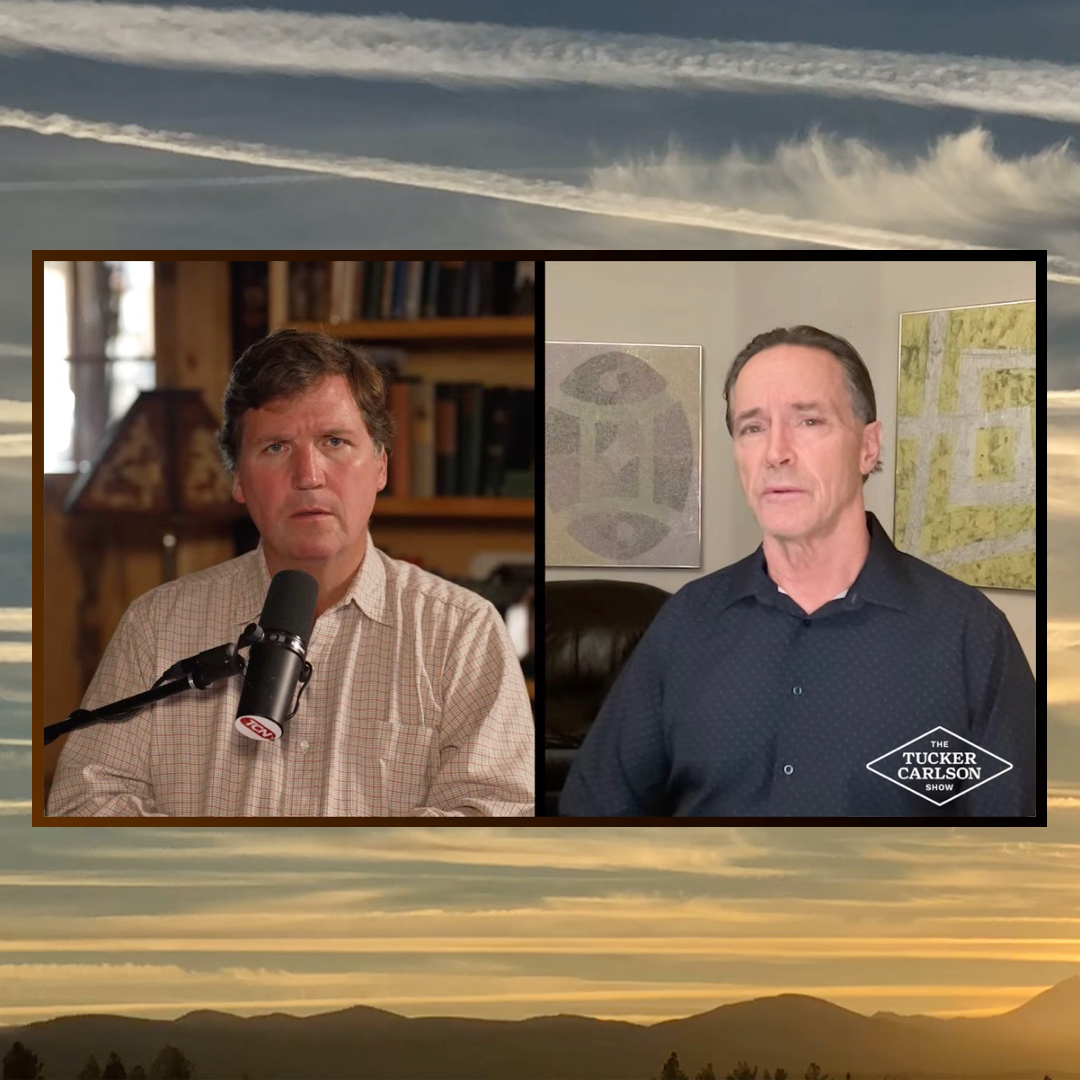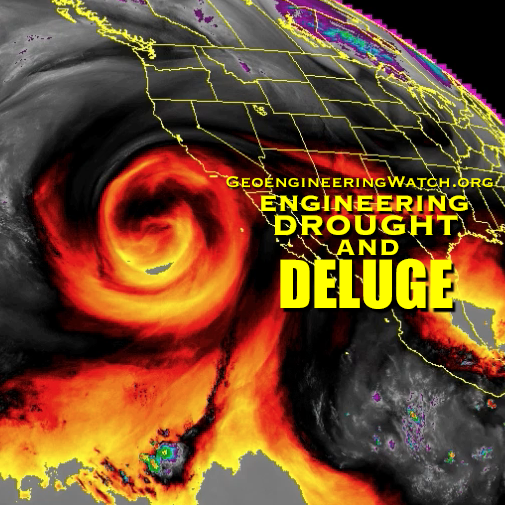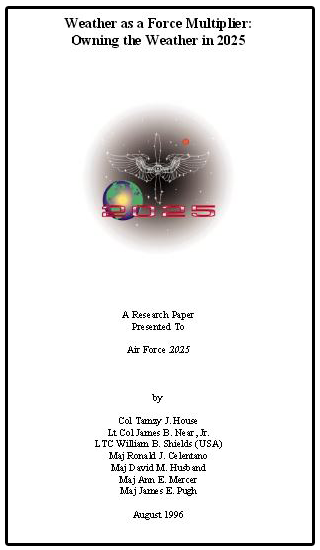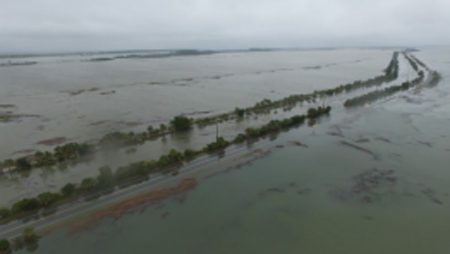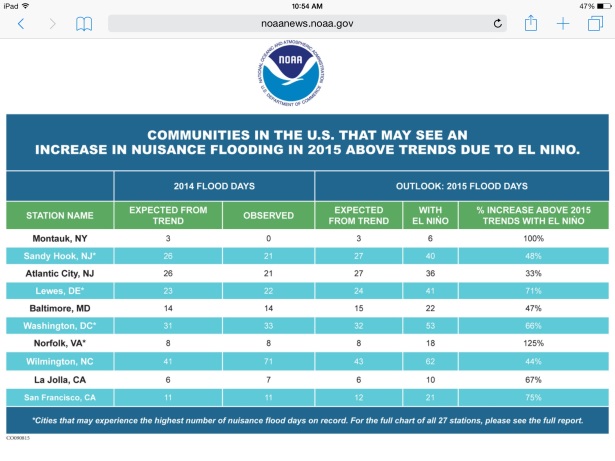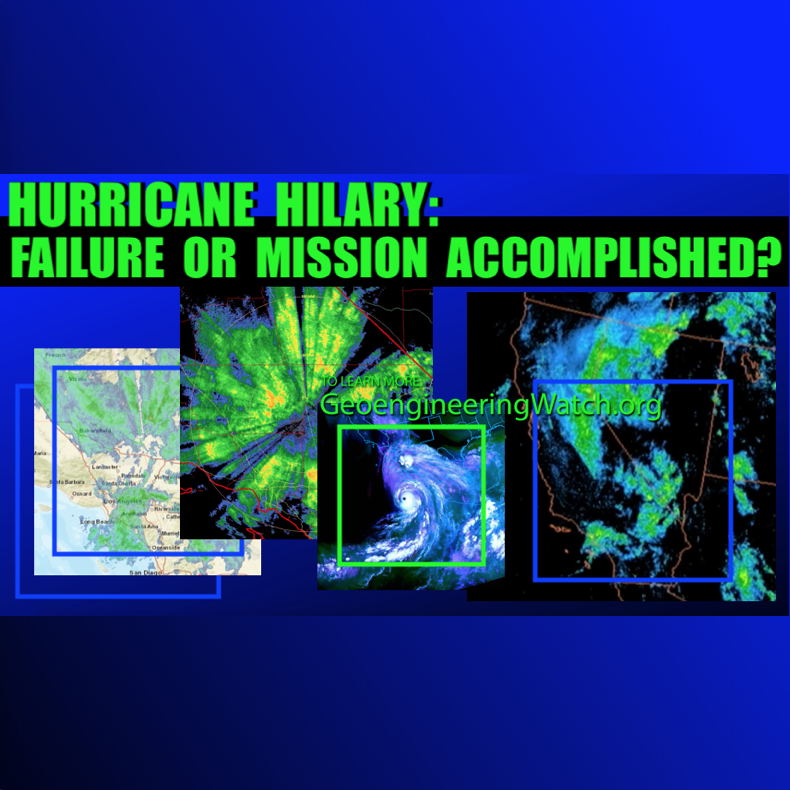Source: Robert Scribbler
According to preliminary reports from NOAA, this Fall, Winter and Spring will likely bring an abnormal number of flooding tides to the US East Coast. These emperor and king tides are primarily driven by sea level rise — a knock on impact of human-forced warming. But during an El Nino year, as with this year, wind patterns along the East Coast tend to drive tides even higher. At El Nino times, lows tend to form off the US East Coast. These lows tend to generate a consistent northeasterly wind that pushes against the northward flow of the Gulf Stream. This action reduces the Gulf Stream’s ability to pull water away from our shores, and some of that water rebounds against the US East Coast.
During a normal year, this would somewhat increase the height of East Coast tides. But, due to Greenland melt pumping fresh water into the North Atlantic, the heat and salt driven circulation that generates the Gulf Stream is weakening (See Signs of Gulf Stream Weakening). So this year’s series of El Nino lows are forming over seas that are already rebounding against the US East Coast. Forming in seas that have already risen due to the melting of glaciers around the world. A NOAA press release from September notes that recent findings:
“…build upon two nuisance flooding reports issued last year led by NOAA scientists William Sweet and John Marra. The previously published reports show coastal communities in the United States have experienced a rapid growth in the frequency of nuisance tidal flooding, a 300 to 925 percent increase since the 1960s, and will likely cross inundation tipping points in the coming decades as tides become higher with sea level rise”
“We know that nuisance flooding is happening more often because of rising sea levels, but it is important to recognize that weather and ocean patterns brought on by El Niño can compound this trend,” said Sweet.”
(The 2015 El Nino — the year sea level rise came home to roost for the US East Coast. NOAA predicts a significant increase in the number of tidal flooding events all up and down the East Coast due to a combination of El Nino and impacts related to human-forced climate change. Image source: NOAA.)
It is due to this confluence of factors that we are likely to see some pretty extreme flooding tides anywhere from Miami to Maine. Flooding tides that, according to NOAA, are 33 to 125 percent more frequent than even the recently elevated trend. Tides that, as we have already seen (see below) are much higher than during any typical year — El Nino or no. Such impacts are likely to occur even without the influence of strong Nor’easters. But for the East Coast, Nor’easters and El Nino tend to go hand in hand.
So it’s shaping up to be a flooding season. One that wouldn’t have happened before. One brought on by the impacts of a human-forced warming. And one that is but a harbinger of more flooding to come.
Fall of 2015 Already Seeing Substantial Inundation Events
Over the past few weeks, a freak series of high tides inundated large sections of the U.S. East Coast. In Charleston, South Carolina, on October 27, a high tide peaked at 8.67 feet above mean low water. That’s the highest tide for Charleston since Hurricane Hugo roared ashore in 1989. But in this case, there was no category 4 hurricane. Just a ridiculous amount of water flooding in from the ocean. In Savannah, Georgia tides ran 10.43 feet above mean low water on the same day. Again, no storm, just a rising ocean flooding out roadways and inundating homes and neighborhoods. Only a couple of days later, on October 29th, large sections of Boston Harbor flooded under perfectly blue skies.
(Flooding, primarily due to sea level rise and an extreme high tide, inundates coastal lands near Tybee, Georgia on October 27th. It was the worst flooding since a category 2 hurricane hit the region in 1935. This year, there was no hurricane. Just sea level rise caused by human forced warming combined with the typical impacts of El Nino on East Coast tides. Image source: Blame Sea Level Rise.)
For stormless days, this level of tidal flooding is unprecedented. It’s a validation, just one month later, of NOAA predictions. If anything, these tides were even higher than expected. Tides influenced by sea level rise, glacial melt in Greenland, and by an El Nino driven shift in wind patterns. Had these tides coincided with a strong Nor’easter or a Hurricane, what we’d be looking at is a level of flooding that would almost certainly have exceeded the worst such events ever to strike the US East Coast. In effect, what we see is that sea level rise due to human forced warming of the globe is starting to have a greater and greater impact on these shores. An awful and early impact that will only worsen as time and human warming progress.
A Global Problem Set Off By Human Warming
Over the longer term, there are a lot of people in the path of this global trend of rising waters. In the US alone, more than 143 million people live in coastal communities. And the seas, due to human-forced warming are on the rise.
But its not just the US East Coast that’s in trouble. Practically everywhere, seas are rising. Global temperature increases of about 1 degrees Celsius above 1880s values are causing the oceans to thermally expand. In addition, glacial melt from mountain systems, Greenland and Antarctica is contributing ever-increasing volumes of water to the global ocean, forcing on the waters’ rise at ever-increasing rates. Currently, long term trends indicate a 3.3 millimeter per year average increase in the height of the world’s oceans (from 1993 to present). And as the world starts to close in on 2 degrees Celsius above 1880s averages, the pace of that rise is expected to ramp up and up.
Already, current sea level rise presents increasing problems to coastal regions across the globe. Much of the impacts we presently see are due to salt water invasion of low lying regions, nuisance flooding events, the amplification of storm driven tides, and increasing instances of what are now called king and emperor tides. Adding complexity to this global warming related problem is the fact that seas do not rise in a uniform manner. This lack of global uniformity of sea level rise results from gravity’s affects on the displacement of waters and from the influence of water outflows from glaciers on ocean currents. As a result, global sea level rise can generate hot spots where rates of rise are significantly in excess of the global average.
US East Coast as Sea Level Rise Hot Spot (click image for animation)
(Over the past few months, a bulge of water more than 1.3 feet higher than the 1981 to 2013 global average has expanded off the US East Coast. This bulge is driven by a combination of Gulf Stream slowdown due to Greenland melt, overall sea level rise due to global warming, and due to an El Nino pattern that drives northeasterly winds off the US East Coast. This year, this extreme bulge is expected to bring on a significant increase in the number of flooding tides. Tides that could be compounded by the effects of strong nor’easters that tend to be generated during El Nino years. Image source: NOAA CPC.)
Unfortunately, as we have seen above, the impacts of gravity rebound and current changes related to glacial melt put the East Coast of the United States directly in the path of a significant rise in ocean water. Specifically, Greenland melt results in a slowing down of the Gulf Stream. And it is the northward draw of the Gulf Stream that pulls about 3 feet worth of sea level rise away from the US East Coast. Slow down the Gulf Stream by dumping cold water into the North Atlantic and you can get about a foot of sea level increase off the US East Coast. Stop it completely and all that 3 feet of water comes sloshing back. Add any global sea level rise due to ocean warming and glacial melt on top of that and you can see why the US East Coast can quickly get into trouble.
All in all, scientists expect sea level rise for the US East Coast to be nearly double the global average predicted for this Century. And what this means is that more and more coastal flooding is on the way.
Source: Robert Scribbler

























